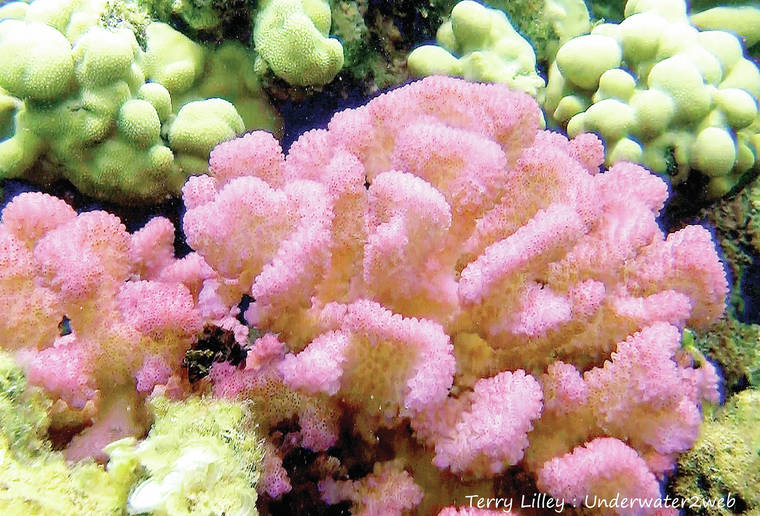Stony, rock hard corals are living animals, and here in Hawaii are known as koa. The coral animal is called a polyp, and it is a very tiny creature that looks like an upside-down jellyfish. These small, soft-bodied animals build strong calcium-carbonate houses for protection, and that is what we know as coral. When millions of coral polyps live in a colony they build an entire city of calcium-carbonate structures very similar to us humans who live in high-rise apartment buildings. The coral structure is very similar to concrete, and when the tiny coral animal died the hard structure it built is left behind, and over millions of years this is what builds our coral reefs.
Stony, rock hard corals are living animals, and here in Hawai‘i are known as “koa.” The coral animal is called a polyp, and it is a very tiny creature that looks like an upside-down jellyfish. These small, soft-bodied animals build strong calcium-carbonate houses for protection, and that is what we know as coral. When millions of coral polyps live in a colony they build an entire city of calcium-carbonate structures very similar to us humans who live in high-rise apartment buildings. The coral structure is very similar to concrete, and when the tiny coral animal died the hard structure it built is left behind, and over millions of years this is what builds our coral reefs.
Since the Hawaiian Islands are relatively new islands there has not been enough time for our coral reefs to grow like they have done in older island chains like French Polynesia, so our corals are spread out on the reef. Most coral reefs have hundreds of different species of coral but here in Hawai‘i we have less then 20 species and only about 10 that are seen often by divers. One of the most common species of coral is the cauliflower coral that lives in shallow water right up to the beach, and also down to about 60 feet deep. It is called cauliflower coral because it is shaped like a head of cauliflower and it can grow to about 20 inches wide. Each branching cauliflower coral is an entire city of tiny coral polyps that live on top of each other in their concrete-like homes.
The living cauliflower coral is actually pure white, but when we see them growing on the reef they may be brown, pink, yellow, green or purple. There color is due to a garden that the coral polyp grows within its tissue. Corals grow gardens just like we do as they feed off of the byproducts their gardens of algae produces. So a pink cauliflower coral is growing pink algae within its tissue and a green cauliflower coral is growing green algae. The coral polyps also have stinging tentacles and filter small, floating creatures out of the water for food. When a live coral has its algae garden die then the coral turns pure white. This is called coral bleaching.
•••
Terry Lilley, a marine biologist, lives in Hanalei. His websites include underwater-2web.com and www.gofundme.com/5urrm4zw.

Subscribe today for unlimited access.
Already a subscriber?
Login
Not ready to subscribe?
Register for limited access.
If you have a print subscription but require digital access,
activate your account.




